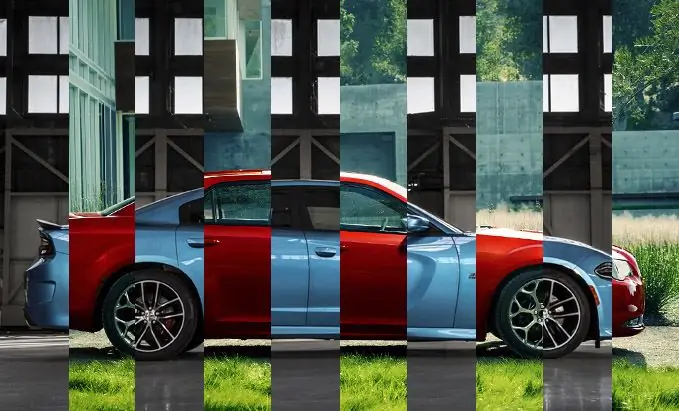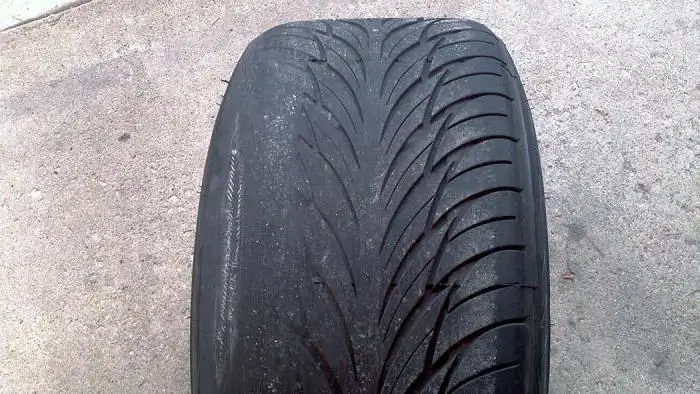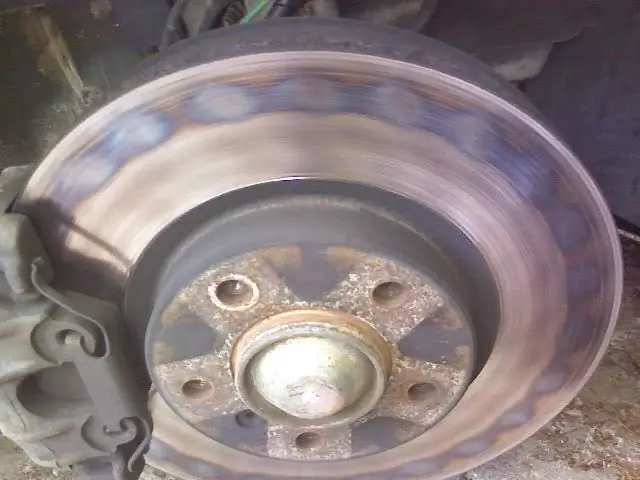2025 Author: Erin Ralphs | [email protected]. Last modified: 2025-01-22 21:14:09
Wheel alignment plays a big role in the operation of the car - if properly observed, they can increase the life of various components, as well as improve driving comfort. But at the same time, many do not understand how to observe them and why it is necessary.
What effect does this have?

Ideally, the wheel should always be set strictly perpendicular to the roadway, and such wheel alignment allows for maximum stability, as well as minimal resistance. In addition, compliance with this rule reduces tire wear and fuel consumption, which also has a very positive effect on vehicle operation. But, unfortunately, such an ideal cannot be achieved.
Wheel alignment angles are constantly changing in the process of changing road conditions, load or various turns, so the designers put into the car several dozens of different parameters that determine the most optimal position under different conditions. Most of these parameters are set as constant values, while other wheel alignments can be adjusted throughout operation.vehicle.
In modern foreign cars, only such a parameter as toe-in is provided for, but such a seemingly positive side also has disadvantages. For example, if the geometry of the body or running gear is disturbed due to physical damage, then the wheel alignment can be adjusted, and if only the toe-in is adjusted, it is necessary to carry out a complete replacement of the affected parts, which quite often are far from being so cheap.
Pitch
Measured between the vertical and the line that passes through the center of rotation of the ball joint, as well as the bearing of the telescopic strut support in a plane parallel to the longitudinal axis. It helps to stabilize the steered wheels, that is, it allows the car to move straight if the driver does not hold on to the steering wheel. For a clear understanding of caster, remember a motorcycle or bicycle, in which the steering column always deviates back, which is why during the movement, if the wheel alignment is not adjusted, they constantly strive to return to a straight position.
It is due to the caster, if the driver does not hold on to the steering wheel, the car drives straight, and after turning it starts to automatically return the wheels to the standard position. If you change the angles of the front wheels, then in this case it will be more difficult to drive the car, since you need to constantly steer, and this is a rather tedious task not only for the driver, but also for his tires, which wear out quite quickly. If you increase the caster, then the car will start to drive along the road, as if on tracks, and turning the steering wheel will require extremely heavy physical effort. Of course, all of the above applies more to rear-wheel drive cars, in which the angles of the front wheels are adjusted a little differently, because in front-wheel drive a slight positive caster value is done in order to stabilize the wheels during coasting, as well as when sudden side loads or braking appear.
If the steering angles are set incorrectly, the car will start to move to the side when driving, and the driver will have to make considerable efforts to turn his vehicle to the left and right.
Camber angle

Measured between the vertical and the plane of rotation of the wheel. In other words, regardless of how the racks and levers tilt during movement or load changes, the angles of the steered wheels with respect to the road must remain within the specified limits. In the event that the upper part of the wheel deviates outward, the camber is called positive, and if it is tilted inward, it is called negative. If there are any deviations from the recommended wheel alignment data, the car begins to gradually drift to the side, and uneven tread wear is observed.
Convergence
Represents the angle between the longitudinal axis of the car and the plane of rotation of the wheel. Setting the wheel toe angles allowsto achieve the correct position at any speed of movement and regardless of the angle of rotation of the car. If there is increased convergence, then this provokes sawtooth wear on the outer part of the tread, while a negative angle affects the inside in the same way. At the same time, it should be noted that if such problems occur, the tires can start to squeal in turns, the car's handling is significantly reduced, and fuel consumption also increases significantly, since there is increased rolling resistance of the front wheels, which negatively affects the car's runout.
In addition to those indicated, there are also angles, the occurrence of which is undesirable - these are the angles of movement, as well as displacements in one or more axes. If a motorist encounters such problems, you need to send the car to a car service, where wheel alignment angles will be checked by professionals. Nissan and other high-quality foreign cars are also subject to similar problems, and if they are present, most often it is necessary to repair the suspension or restore the car body.
When and why are adjustments made?

In most cars of Nissan, VAZ and other brands that are not equipped with MacPherson suspension, the camber for the front wheels often has a small positive value (from 0o to 45 o), which reduces the effort on the steered wheel, and also reduces the transmission of all kinds of jerks to the steering. If the car uses MacPherson suspension, then the wheelshave little or no negative camber.
During operation, various parts of the suspension are subject to natural wear, as a result of which the installation angles are violated. That is why from time to time (in accordance with the instructions) you need to measure the angles of the rear wheels and, if necessary, adjust them.
Most often, "unscheduled" adjustment is required for modern vehicles after hitting all sorts of pits or obstacles, as well as after participating in an accident that caused damage to the body. If you notice any changes in the behavior of the machine due to such cases, you should immediately take it to a service station.
Among other things, it also happens that you have to go to the "breakers" after the replacement of suspension and steering parts that affect the position of the wheels has been carried out.
If you have not encountered any of the above cases, but at the same time you think that your wheel alignment parameters are violated, then try to analyze the current situation and understand what could have preceded the change in the nature of the ride. For example, if you previously had other wheels, then if they are unbalanced, vibration and uneven tread wear may appear. It is also worth noting that if the wheel bolts are not tightened enough, the car may periodically shake, and in addition, tires with defects, different sizes, patterns, and even the degree of inflation can also lead to abnormal behavior of your car on the road.
If the car pulls to the side, it is oftenhappens due to the braking of a wheel, as well as due to malfunctions in the brake mechanism, while broken shock absorbers adversely affect the behavior of your car on the road. Heavy steering is due to a problem with the power steering, and reduced coast is the cause of the wheel bearings.
Thus, it is far from always worth "sinning" at the wheel alignment angles. VAZ and other domestic cars are especially prone to such malfunctions, so it is best to start checking with them.
Where to repair?
First of all, try to find a really professional master, and do not try to look for people with the best equipment and stands. The service should be chosen according to your needs, otherwise you will overpay for something that you really do not really need.
For example, if the car is in good condition, and you just want to check and adjust the toe, it is not at all necessary to use a 3D wheel alignment stand. A competent specialist can easily cope with such problems using a measuring rod and a standard lift, and with the same result, will offer a much lower cost. If you want to check all the geometry, then you really need specialized equipment here.
What is equipment like?

Stands on which the wheel alignment angles are checked and their adjustment are divided into two mainvarieties - computer and optical. Each option has its own features and benefits.
Optical
These stands are divided into two categories - laser and beam. In the latter, an incandescent lamp acts as a light source. Two sources are fixed on the wheels, and measuring screens are installed on the side and front of the car, onto which a light beam is projected. When the vehicle's wheel alignment is adjusted, the beams are directed to a measuring rod in front of the vehicle. Laser ones are more accurate, and it is more convenient for the master himself to work on them. Measuring screens are installed on the sides of the lift or pit, in the center of which holes are made, through which the lasers are directed at each other. Mirrors are installed on the wheels, with which the rays are reflected on the screens.
The advantage of optical stands is their simplicity, as well as reliability in use and relatively low cost, but their disadvantages are quite significant. First of all, they are less accurate than computer ones, they can work simultaneously only with a particular axle of the car, and they also do not provide for the possibility of using a special database of models in the work. Among other things, they do not have the ability to measure some of the parameters that characterize the overall "geometry" of the car. Thus, if the car uses a multi-link suspension, checking and adjusting the wheel alignment on optical stands is contraindicated for it.
Computer

This type of stands also has two subspecies - these are 3D and CCD (sensor). In the latter, measuring heads are fixed on each wheel, the data from which will be processed by a computer. According to the method of connection used between the heads, stands can be corded, as well as infrared wired or wireless. The latter type is currently the most common, but when choosing, one should also take into account the fact that computer stands with an open circuit are sometimes used today, which are much worse in their functionality compared to devices with a closed circuit.
The advantages of computer stands are obvious: multitasking, extremely high accuracy, the ability to measure many more characteristics, as well as the use of a continuously updated database. It is also worth noting that such equipment uses a specialized program that tells the mechanic the sequence of actions. But such stands are not without drawbacks - they have rather fragile sensors, and they also depend on lighting and temperature conditions.
With the advent of computer 3D-stands, there was literally a revolution in the field of checking and adjusting wheel alignment. A special camera is attached to the rack in front of the car, which allows you to fix the position of plastic reflective targets on the wheels with perfect accuracy. To measure the angles, just roll the car back and forth literally 20-30 centimeters, and then turn the steering wheelin different directions. After that, the information received from the cameras is carefully processed by a computer that provides all the necessary geometric parameters in real time. This technology is now called “machine vision.”
Special attention should be paid to the fact that modern 3D stands, unlike the others, do not provide for the need to place the car on a perfectly flat surface.
Subtleties of work

You can only go for a wheel alignment if you have a working steering and running gear, and before the adjustment is carried out, the master must check these parameters. The car is raised on a lift, and then the specialist inspects and moves the wheels, levers, rods, springs and performs many other necessary actions.
It is mandatory to measure and, if necessary, bring the tire pressure to normal. If there is too much play or any physical damage to the parts, the specialist must necessarily stop the procedure and refuse the client to carry out the adjustment if it is not possible to fix the problem on the spot.
If, nevertheless, no deviations were found, the car is installed on a horizontal platform, after which it is loaded in full accordance with the manufacturer's recommendations. In other words, if the angle values for a particular load were specified at the factory, then it would be a direct violation to try to adjust them absolutely.empty car. To install the suspension parts in the working position, first press it with force, pressing down the rear and front of the car. In order to avoid serious errors in the measurement process, the disk runout is pre-compensated, regardless of which stand the adjustment is carried out on. To carry out this procedure, the master hangs out the axle, measuring instruments are attached to the wheels, and then they are scrolled. On modern 3D stands, compensation is carried out without hanging by rolling the machine in different directions by 20-30 cm.
How is the adjustment done?

Since all installation angles are interconnected, when adjusting them, professionals try to follow an extremely clear sequence. First, the castor is adjusted, and then the camber and toe are changed. In the vast majority of modern foreign cars, only the last parameter is adjusted.
Castor adjustment involves changing the number of washers, while the wheels of the car are braked by the service brake system (but not by the handbrake) - for this, a specialized pedal lock is used in the workshops. In principle, the procedure for adjusting the castor is one of the most time-consuming for the "razvalshchikov", it takes a lot of time, and therefore many do not like it. Some specialists may even chisel washers, while others simply do not emphasize castor or try to convince their clients that thisthe corner is in perfect order, so you should always be vigilant.
Camber adjustment on double-lever suspensions is carried out in exactly the same way as in the case of castor. On a MacPherson type suspension, in most cases, the camber is changed by rotating a special eccentric bolt, with which the rack is attached to the steering knuckle, but other options can be used. For example, on some models, instead of such a bolt, a special slider mechanism is installed or an adjusting element can be placed at the base of the lever. There are also designs in which the camber is adjusted by moving the ball joint.
Before adjusting the convergence, the specialist must first set the steering rack to the middle position, and the steering wheel should stand straight and be fixed with a special lock. Adjustment is carried out by turning the adjusting collar of the handpieces on each side (never on one side). One of the signs of a correctly performed operation is the straight position of the steering wheel without any distortions in the process of rectilinear movement. At least on this basis, you can always determine how well the adjustment was carried out and whether it really helped you cope with problems while riding.
Recommended:
What is the difference between front-wheel drive and rear-wheel drive: the difference, advantages and disadvantages of each

Among car owners, even today, disputes about what is better and how front-wheel drive differs from rear-wheel drive do not subside. Each gives his own arguments, but does not recognize the evidence of other motorists. And in fact, it is not easy to determine the best type of drive among the two options available
Car stability and handling: criteria and factors

Car handling is a factor that worries many drivers. Not only the speed of movement, but also the safety of passengers depends on it. There are several levels of control - basic and "advanced". In this article you can find information on how to improve car handling and whether it is necessary to do this for ordinary city trips
Adjusting wheel alignment. How to adjust wheel alignment yourself. Wheel alignment stand

Today, any service station offers wheel alignment adjustment. However, car owners can carry out this procedure on their own. So they will learn to better understand and feel their car. Auto mechanics unanimously argue that it is extremely difficult to set up a wheel alignment on your own. Actually it's not like that
Why does the steering wheel vibrate when braking on the VAZ-2110, Chevrolet Lacetti, Opel Astra? Steering wheel vibrates when braking at speed

A car is a vehicle of increased danger. When driving, all controls must be in good working order. However, it happens that the steering wheel vibrates when braking. Opel Astra is also not immune from such a problem. Let's look at the causes of this malfunction and how to fix them
Steering technique: turning the steering wheel when turning. Creaking, crunching when turning the steering wheel, what do they mean

Few drivers think about, for example, how correctly they hold the steering wheel, considering this an unimportant nuance that does not affect the quality of driving; Or what should be the turn of the steering wheel when turning. In fact, there is a whole technique for handling the steering wheel

